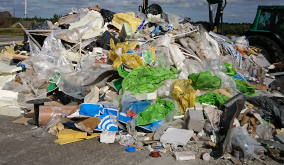
Construction waste. © The Karelia University of Applied Sciences
The Karelia University of Applied Sciences is investigating whether it would be profitable to establish an industrial-scale plant in the North Karelia region, which would handle construction and agricultural plastics collected from the region. The topic has been studied in several theses. The investigation is part of the Circwaste subproject in North Karelia.
Recycling plastic is more environmentally friendly than incineration
One thesis compared the life cycle effects of incineration and recycling of plastic derived from construction waste. By incinerating plastic, emissions from manufacturing can be avoided by approx. 0.6–0.7 t CO2-eq/t. This means that by incinerating one tonne of sorted plastic from the construction site, about 25 per cent of the plastic’s life cycle carbon footprint can be avoided.
Correspondingly, the recycling of plastic avoids carbon dioxide emissions of about 1.2–1.4 t CO2-eq/t. Recycling reduces the carbon footprint of a plastic life cycle by about 50 per cent. Based on these observations, it appears that, in terms of environmental impact, plastic recycling would be a clearly better option than incineration.
The same study also looked at the amounts of different types of plastic generated on the construction site. Based on the results, most of the plastic waste generated on the construction site is packaging, protective and film plastic or PE-LD. Most of that plastic was visually fairly clean, but some have dust and other contaminants from the construction site.
Collecting plastic from farms cost-effectively
The Karelia University of Applied Sciences has also studied the transport and collection costs of agricultural plastic collection and considered improving the cost-effectiveness of operations in North Karelia. About 21 million tonnes of waste are generated annually in agriculture in Finland, of which about 12,000 tonnes is plastic waste. A significant part of plastic waste is bale plastic, which accounts for about half of all the plastic waste. However, agricultural waste is not covered by municipal waste management and thus farmers are responsible for the proper treatment of plastic waste.
“There haven’t been any permanent solutions for the collection of agricultural plastics and the costs of collection have hardly been studied before in Finland," says Simo Paukkunen, Project Specialist at the Karelia University of Applied Sciences. In the autumn of 2019, Central Union of Agricultural Producers and Forest Owners MTK and the Itä-Suomen murskauskeskus Oy began collecting agricultural waste plastic, but Paukkunen does not yet have any detailed information on the scope of operations.
Based on a modelling, the most cost-effective option for farmers and the most efficient option for transport companies was to collect plastics from farms every three years. "Previous studies have examined the pain threshold of farmers for the collection price of plastic and collecting plastic every three years falls into this price range," says Paukkunen.
In terms of quantity, the amount of agricultural plastics alone remains so small that it is not profitable to operate on an industrial scale. However, there could be potential if the film plastic of construction waste could be utilised in addition to agricultural plastics in material flows. The study excludes the economic competitiveness of plastic products because, for example, recycled products made from waste plastics are not suitable for food use.
Unique composite plastic from waste-derived materials
The Circwaste subproject of South Karelia is also investigating the possibilities of utilising building-derived plastic material on a pilot scale. A pilot line for the production of composite material of construction waste has been established at the Kukkurinmäki treatment centre in Lappeenranta. Product development is carried out in cooperation between LUT University and Wimao Oy.
“The compositions of waste-derived material streams vary, which brings its own challenge to product manufacturing,” says Sami Matthews, Postdoctoral Researcher at LUT University.
LUT's subproject also examines which processing methods and working stages are best suited for products made from recycled fibre composites. The LUT study is exploring an alternative to the injection moulding method using the compression moulding method as wood fibres present challenges in utilising traditional injection moulding. Wood fibres do not withstand high temperatures or pressures, so processing conditions should be optimal.
Based on the tests, it also appears that the composite material, in terms of its technical properties, would meet the properties required for industrial-scale production. The cutting surface of the material is of high quality and does not crumble.
Globally, the research conducted by LUT is unique. “In our view, no one else is currently researching the post-processing of wood-plastic composites,” says Matthews. In the future, the mechanical durability of recycled material and the potential risks before switching to mass production will be further investigated.
Read more